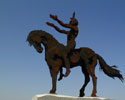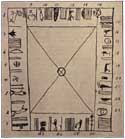
 |
|
Spirituality |
Kaw people had a profound respect for the
spiritual dimension of the universe and placed considerable
importance on bringing their lives into harmony with this
greater presence. The Kaw name for this Great Spirit that
pervaded all things was Waucondah. Waucondah was
more a quality than a definite entity. Waucondah existed
in the sun, light, darkness, heat, cold, rivers, woods, hills,
wind, mists, stones, plants, and animals.
|

|
|
This meant that everything
that the Kaws came into contact with contained a spiritual
dimension and so respect and consideration were to be given to
all places and things. This sensibility imbued the Kaw culture
with an intimacy with the landscape that Euro-Americans have
never really understood.
The Kaws had no symbol for Waucondah because they believed
that a particular image could not contain or convey Waucondah’s
all-powerful and pervasive presence. However, some Kaws intimated that Waucondah’s voice was sometimes
manifested in the sound of thunder.
|
Great Spirit Spring
Of special religious importance to the Kaws and other tribes of the central
plains was a spring located near the confluence of the north and south forks of
the Solomon River near present Cawker City, Kansas.
In August of 1866 David E. Ballard, a surveyor, provided a description of this
unique and spiritually-potent land form: |

|
|
" . . . is a remarkable Salt Spring. Known among the
Indians and hunters that frequent that region, as the Wac-an-da or Great
Spirit Spring. The Spring itself is a natural curiousity, it being located on
the summit of a cone shaped limestone rock. The rock is circular, about 200 feet
in diameter at the base and about 30 feet high, upon the summit of this, rests
the spring, the basin being circular and about 30 feet in diameter, its outlet
is a trough apparently formed by the action of the water upon the rock. The
water in the spring is about 20 feet deep and exceedingly strong with salt, . .
."
A clear understanding of both the spiritual meaning of Waconda
Springs to the Kaws and the rituals they performed there will always elude
us. And Waconda Springs will never be seen again. A few weeks
before the waters of the Glen Elder Reservoir inundated the site in the early
1960s, this remarkable earth feature, revered by generations of Kaws, was
bulldozed into oblivion.
|
 |
Apparently the Kaws offered prayer-songs to deities
lesser than Waucondah. In an 1885 article, Mourning and War Customs of
the Kansas, author J. Owen Dorsey included a chart drawn by a Kaw spiritual leader,
Pa-ha-le-gaq-li, son of the great
Kaw chief Al-le-ga-wa-ho.
This chart served as a guide in singing prayer-songs to spiritual entities.
|
|
|
There are twenty-seven figures in all, with from one to ten lines beside each
figure representing the number of songs of praise and propitiation offered to
each deity. Among the deities are the sacred pipe, winds, the planet Venus, big
rock, wolf, moon, crow, buffalo bull, and owl.
Dorsey writes: "Paha le-gaqli said that there should be a
representation of fire in the middle of his chart, but he was afraid to make it.
The songs are very sacred, never being sung on ordinary occasions, or in a
profane manner, lest the offender should be killed by the thunder-god."
|
|
|
|
|


